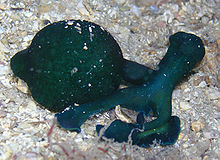
The Sipuncula or Sipunculida is a class containing about 162 species of unsegmented marine annelid worms. The name Sipuncula is from the genus name Sipunculus, and comes from the Latin siphunculus meaning a "small tube".

The Echiura, or spoon worms, are a small group of marine animals. Once treated as a separate phylum, they are now considered to belong to Annelida. Annelids typically have their bodies divided into segments, but echiurans have secondarily lost their segmentation. The majority of echiurans live in burrows in soft sediment in shallow water, but some live in rock crevices or under boulders, and there are also deep sea forms. More than 230 species have been described. Spoon worms are cylindrical, soft-bodied animals usually possessing a non-retractable proboscis which can be rolled into a scoop-shape to feed. In some species the proboscis is ribbon-like, longer than the trunk and may have a forked tip. Spoon worms vary in size from less than a centimetre in length to more than a metre.

Nemertea is a phylum of animals also known as ribbon worms or proboscis worms, consisting of 1300 known species. Most ribbon worms are very slim, usually only a few millimeters wide, although a few have relatively short but wide bodies. Many have patterns of yellow, orange, red and green coloration. The foregut, stomach and intestine run a little below the midline of the body, the anus is at the tip of the tail, and the mouth is under the front. A little above the gut is the rhynchocoel, a cavity which mostly runs above the midline and ends a little short of the rear of the body. All species have a proboscis which lies in the rhynchocoel when inactive but everts to emerge just above the mouth to capture the animal's prey with venom. A highly extensible muscle in the back of the rhynchocoel pulls the proboscis in when an attack ends. A few species with stubby bodies filter feed and have suckers at the front and back ends, with which they attach to a host.
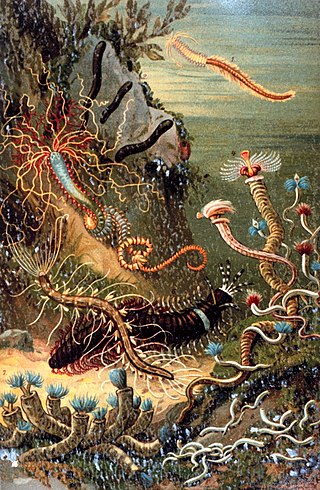
Polychaeta is a paraphyletic class of generally marine annelid worms, commonly called bristle worms or polychaetes. Each body segment has a pair of fleshy protrusions called parapodia that bear many bristles, called chaetae, which are made of chitin. More than 10,000 species are described in this class. Common representatives include the lugworm and the sandworm or clam worm Alitta.

Urechis unicinctus, known as the fat innkeeper worm or penis fish, is a species of marine spoon worm in East Asia. It is found in Bohai Gulf of China and off the Korean and Hokkaido coasts. It is not to be confused with a closely related species, Urechis caupo, which occurs on the western coast of North America and shares common names. The body is about 10–30 cm long, cylindrical in shape and yellowish-brown in color. On the surface of the body there are many small papillae.
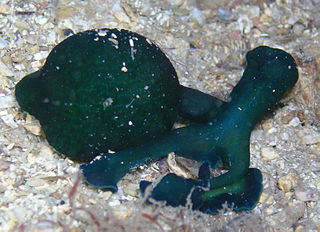
Bonellia viridis, the green spoonworm, is a marine worm noted for displaying exceptional sexual dimorphism and for the biocidal properties of a pigment in its skin.

Cirratulus cirratus is a species of marine polychaete worm in the family Cirratulidae. It occurs in the littoral and sub-littoral zones of the Atlantic Ocean.

Lanice conchilega, commonly known as the sand mason worm, is a species of burrowing marine polychaete worm. It builds a characteristic tube which projects from the seabed, consisting of cemented sand grains and shell fragments with a fringe at the top.
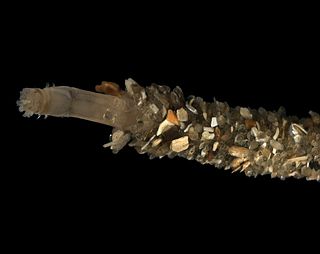
Oweniidae is a family of marine polychaete worms in the suborder Sabellida. The worms live in tubes made of sand and are selective filter feeders, detritivores and grazers.
Harrimania planktophilus is a marine acorn worm in the family Harrimaniidae. It lives in a burrow in sediment on the sea floor. It is only known from western Canada and was first described by Cameron in 2002. The species name is from the Greek and translates as "lover of plankton".
Listriolobus pelodes is a species of marine spoon worm. It is found in shallow seas in the North East Pacific off the coast of California. It lives in a burrow in soft sediments.
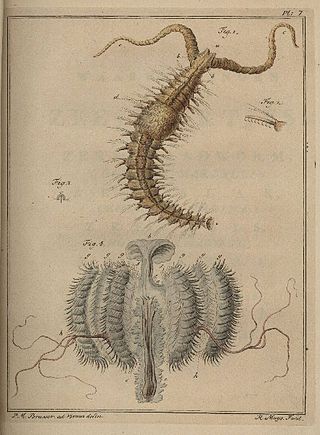
Polydora ciliata is a species of annelid worm in the family Spionidae, commonly known as a bristleworm. It is a burrowing worm and is found in the northeastern Atlantic Ocean and some other parts of the world.
Metabonellia is a genus of marine spoon worms in the family Bonelliidae. It is a monotypic genus and Metabonellia haswelli is the only species. It is commonly known as the green spoon worm and is found in shallow waters around Australia.

Urechis caupo is a species of spoon worm in the family Urechidae, commonly known as the innkeeper echiuran, the fat innkeeper worm, the innkeeper worm, or the penis fish. It is found in shallow water on the west coast of North America, between southern Oregon and Baja California, where it forms a U-shaped burrow in the sediment and feeds on plankton using a mucus net.

Echiurus echiurus is a species of spoon worm in the family Echiuridae. It is found in the North Atlantic Ocean and a subspecies is found in Alaska. It burrows into soft sediment and under boulders and stones in muddy places.

Ikedidae is a family of spoon worms in the suborder Bonelliida. It is a monotypic family, the only genus being Ikeda. These worms burrow into soft sediment on the seabed.
Ikeda taenioides is a species of spoon worm in the family Ikedidae. It is native to the northern Pacific Ocean where it is found in the subtidal waters around Japan.
Maxmuelleria lankesteri is a species of spoon worm in the family Bonelliidae. It is found in the North Atlantic Ocean. It burrows into soft sediment on the seabed, mostly in deep water.
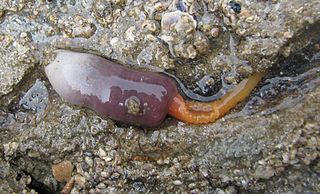
Thalassema is a genus of spoonworms in the subclass Echiura.

Maldanidae is a family of more than 200 species of marine polychaetes commonly known as bamboo worms or maldanid worms. They belong to the order Capitellida, in the phylum Annelida. They are most closely related to family Arenicolidae, and together form the clade Maldanomorpha.
